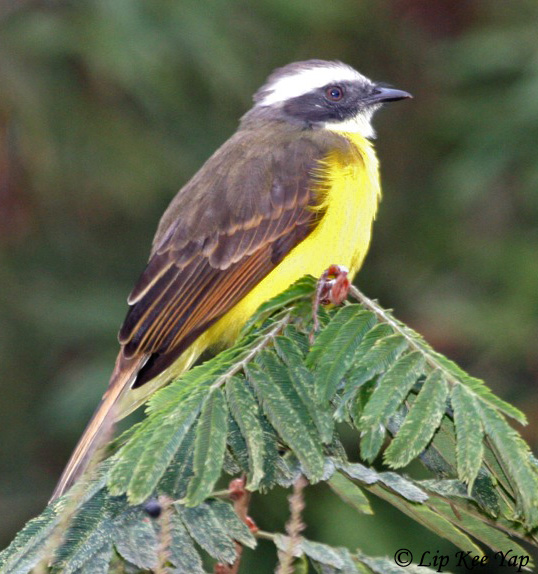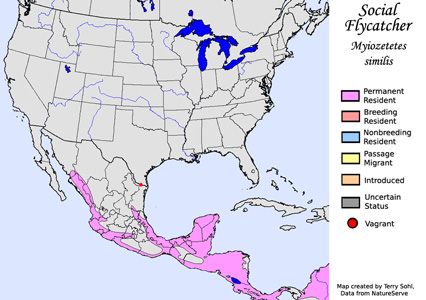| Length: 6.75 inches | Wingspan: 9.75 inches | Seasonality: Non-resident in South Dakota |
| ID Keys: Greenish-brown upperparts, brownish wings and tail, bright yellow underparts, bold black-and-white facial pattern. Orangish crown stripe (often not visible) | ||
 The
Social Flycatcher is a common species with a wide geographic range from
Mexico, through Central America, and into much of northern South America.
In the United States, they are known from a handful of records in southern
Texas. The first sighting in the United States occurred in January of
2005. In their native range, they have adapted very well to a human
presence, and are often found in and around suburban areas.
The
Social Flycatcher is a common species with a wide geographic range from
Mexico, through Central America, and into much of northern South America.
In the United States, they are known from a handful of records in southern
Texas. The first sighting in the United States occurred in January of
2005. In their native range, they have adapted very well to a human
presence, and are often found in and around suburban areas.
Habitat: Found in a very wide variety of open woodland and semi-open habitats. They can be found in and around forest clearings, forest edges, shrublands, agricultural areas, and also in suburban settings. They are often found near water, near the shores of lakes and rivers.
Diet: Most often feeds on insects, fruits, and berries. They have also on occasion been found to feed on small vertebrates such as small frogs and tadpoles.
Behavior: Forages by observing from a perch, and flying out to capture insects, including by hovering and gleaning insects from foliage. They are a social species and can often be found foraging in large groups, particularly when feeding on fruits and berries.
Nesting: The nest of a Social Flycatcher is a large dome of grasses, twigs, and often, man-made material such as bits of plastic or other debris. The female builds the nest and lays between 2 and 4 eggs. She alone incubates the eggs. The young fledge about 18 days after hatching.
Song: Has a variety of harsh calls, including a buzzy trill, a sharp peeurrr, and a harsh twittering call.
Migration: Considered a permanent resident throughout much of their range. In some areas, they are short-distance migrants.
Interactive eBird map: Click here to access an interactive eBird map of Social Flycatcher sightings
Similar Species: Similar to other Myiozetetes species, but the Social Flycatcher is the only one to have been seen in the United States. Unlikely to be confused with other species found in the United States.
Conservation Status: Overall populations are very large, spread over a wide geographic area, and they are common in many areas. The IUCN lists the Social Flycatcher as a species of "Least Concern".
Further Information: 1) BirdLife International - Social Flycatcher
2) Avian Web - Social Flycatcher
3) WebSite of Everything - Social Flycatcher
Photo Information: Photo taken by Lip Kee Yap - Taken on April 6th, 2006 in Argentina - Photo licensed under Creative Commons Attribution ShareAlike 2.0 Generic License.
| Click below for a higher-resolution map |
 |
| South Dakota Status: Non-resident in South Dakota |
Additional Social Flycatcher Photos (coming soon!!)
